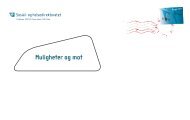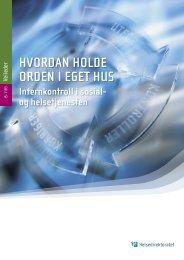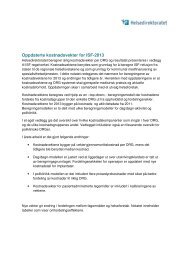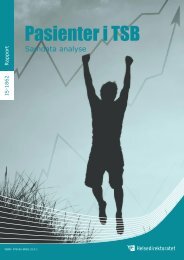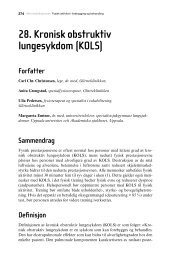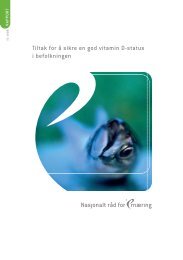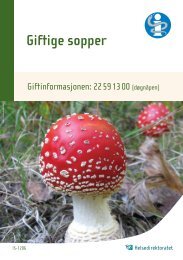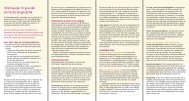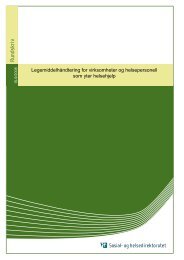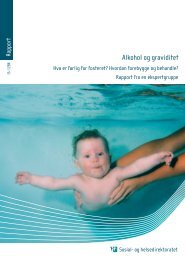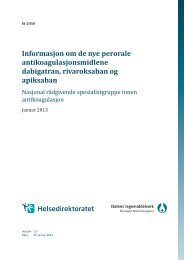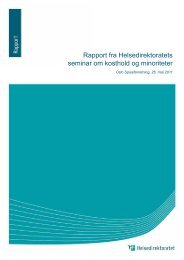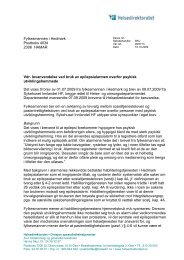Food allergy Dual –allergen exposure hypothesis ... - Helsedirektoratet
Food allergy Dual –allergen exposure hypothesis ... - Helsedirektoratet
Food allergy Dual –allergen exposure hypothesis ... - Helsedirektoratet
You also want an ePaper? Increase the reach of your titles
YUMPU automatically turns print PDFs into web optimized ePapers that Google loves.
Primærforebyggende /ltak –<br />
myter for fall?<br />
Primary preven/on;<br />
myths and reali/es<br />
Karin C. Lødrup Carlsen<br />
Professor MD, Head of research<br />
Women and Children’s division, Oslo University Hospital<br />
Faculty of Medicine, University of Oslo,<br />
Norway<br />
ORAACLE<br />
Oslo Research group for Asthma, Allergy in Childhood; the Lung and Environment
Health: a fine tuned balanced between man and environment<br />
First line of defence DisrupJon in host: eg<br />
www.humanillnesses.com<br />
InfecJons Allergy
Primary prevention<br />
• Is primary prevention possible?<br />
• Prevention for all or some?<br />
• What’s good for some may be bad for others… or?<br />
• Avoidance vs <strong>exposure</strong><br />
• Allergy vs tolerance (natural or induced)
• Risk factors<br />
– Asthma<br />
– Allergic rhiniJs / RhinoconjuncJviJs (AR)<br />
– Atopic Eczema / atopic dermaJJs (AD)<br />
– <strong>Food</strong> <strong>allergy</strong><br />
• From risk factor to intervenJon<br />
• RecommendaJons<br />
• Basis for recommendaJons<br />
• Myths or realiJes?<br />
• Way forward?<br />
Asthma<br />
“Allergy”
Advice today<br />
Environment<br />
Tobacco<br />
Indoor dampnesss<br />
Pets<br />
Other<br />
<strong>Food</strong> and nutrients: (briefly)<br />
Breast feeding<br />
Vitamines<br />
Pro-pre and synbiotics<br />
Allergens
Indoor environment
1. Tobacco smoke <strong>exposure</strong><br />
Unngå røyking innendørs.<br />
Dersom du røyker ute, bør du vente minst e[<br />
minu[ e[er røyking før du går inn, så<br />
lungene kan tømmes for røyk.<br />
Barn er spesielt utsa[ for helseskadelige<br />
effekter av tobakksrøyk i omgivelsene.<br />
De skadelige parJklene I røyken spres i huset<br />
og er kra]ig lu]veisirriterende.<br />
Do not smoke indoors!<br />
Proven beyond doubt for asthma, lung funcJon<br />
development, secretory oJJs media, perinatal<br />
complicaJons, less clear for allergic sensiJsaJon
2. ’Home dampness / humidity problems’<br />
• Significant risk factor for cough, wheeze and<br />
asthma (Bornehag et al, 2001)<br />
• Risk of asthma (age 2) (Wickman et al, 2003)<br />
• wheezing or bronchial obstruction (2-6 years)<br />
(Nafstad et al, 1998, Belager et al, 2003, Jaakkola et<br />
al, 2005)<br />
Mechanisms unknown<br />
Sufficient data support maintaining advice on eliminaJon
3. Pet keeping<br />
Pet keeping is discussed in terms of increasing or reducing <strong>allergy</strong>, but unJl further<br />
clarity; avoid pets in the child’s room.<br />
Families with asthma or <strong>allergy</strong> should consider carefully prior to acquiring pet(s)<br />
Birds indoors spread a lot and strongly allergenic parJcles
Cats in the homes and<br />
sensitisation to cat<br />
Non-‐linear dose<br />
relaJonship <strong>exposure</strong> in<br />
homes to cat and allergic<br />
sensiJsaJon<br />
Allergens many places<br />
Hertzen et al, Allergy 2009<br />
24 European<br />
Birth Cohorts on<br />
Asthma and<br />
Allergy
Pet<br />
Allergic asthma Non-‐Allergic asthma<br />
ownership<br />
Cat, dog, birds or rodents<br />
not asscoiated with non-‐<br />
allergic asthma.<br />
Pet ownership in early life did not appear to either increase or reduce the risk of asthma or<br />
allergic rhini/s symptoms in children aged 6–10.<br />
Advice from health care pracJJoners to avoid or to specifically acquire pets for primary<br />
prevenJon of asthma or allergic rhiniJs in children should not be given.<br />
PLoS ONE 7(8): e43214. doi:10.1371
4. Pollens, plants and <strong>allergy</strong><br />
Careful planning of a green environment is important for all, also for<br />
environmental handicapped (asthmaJcs, allergics and persons with<br />
hypersensiJvity) -‐ parJcularly in children’s environments.<br />
A good green environment promotes health, and is important for<br />
growth and development.<br />
1. Alternative to grass<br />
Grass lawns in the kindergarden and schools are not good for allergic<br />
children. Gravel, sand, tree and stones are good alternatives<br />
2. A “green wall” of trees/shrubs adjacent to roads with traffic can filter<br />
dust and polluJon.<br />
Alder, Hazel, Selje and parJcularly birch must be removed not to be re-‐<br />
planted.
”Karelia surprise:”<br />
Sensitisation to birch:<br />
2 % in Russia<br />
14 % in Finland<br />
Allergy 2007<br />
PARSIFAL & GABRIELA: farm-living<br />
protected for asthma: wider range of<br />
microbial <strong>exposure</strong>s, Could not<br />
identify specific microbes that may<br />
confer protection, environment.
Microbiota<br />
Documentation<br />
INHALED<br />
• Farming environments<br />
• Karelia studies<br />
ORAL<br />
• (Caecarian section)<br />
• GIT microbiota diversity<br />
• RCT pro/pre-biotics, synbiotics
<strong>Food</strong> introduction<br />
<strong>Helsedirektoratet</strong> ; Mat for spedbarn 2011
235 children with a 5 yrs of follow-‐up.<br />
% with wheezing 4-‐12 mo<br />
Rapid early weight gain is a risk factor for clinically relevant<br />
wheezing illnesses in the first years of life and lower lung<br />
function in childhood<br />
One-‐point z-‐score increase in<br />
weight gain<br />
Gave a 37% increase in days<br />
with wheeze
<strong>Food</strong>/ nutrition<br />
• Supplement (enough of good things)<br />
• Avoidance (remove problematic items)<br />
ADVICE:<br />
1) the commencement of complementary foods in general<br />
2) avoidance or <strong>exposure</strong> to specific ‘allergenic’ foods<br />
3) the use of modified allergens, such as the hydrolysed<br />
proteins found in some hypoallergenic formulas.
5. Breast feeding<br />
Infant:<br />
should be exclusively breasCed for<br />
6 months, conJnue for 12 months<br />
PotenJal benefit;<br />
Development of food <strong>allergy</strong> and<br />
atopic eczema my be postponed if<br />
the baby is breasqed for 4-‐6<br />
months<br />
<strong>Helsedirektoratet</strong> ; Mat for spedbarn 2011
<strong>Food</strong> <strong>allergy</strong> <strong>Dual</strong> <strong>–allergen</strong> <strong>exposure</strong> <strong>hypothesis</strong><br />
AD develops as a result of<br />
• Altered barrier skin function<br />
• Abnormal immune reactivity<br />
• Environmental factors<br />
Allergen <strong>exposure</strong><br />
Too much vs too li[le<br />
Both hi’ and lo’ <strong>exposure</strong> é� risk<br />
of <strong>allergy</strong><br />
Oral vs Non-‐oral route<br />
Hudson Nature geneTcs 2006<br />
Lack. G JACI 2012;129:1187-‐97
<strong>Food</strong> <strong>allergy</strong> <strong>Dual</strong> <strong>–allergen</strong> <strong>exposure</strong> <strong>hypothesis</strong><br />
Lack. G JACI 2012;129:1187-‐97<br />
???<br />
Exposure to food<br />
allergen proteins<br />
may require opJmal<br />
microbioJc<br />
environment in GIT<br />
for tolerance<br />
development
8. Allergen avoidance<br />
Children with high risk of <strong>allergy</strong> should have completely<br />
hydrolysed formula from the pharmacy unJl the child is<br />
at least 4 months old<br />
<strong>Helsedirektoratet</strong> ; Mat for spedbarn 2011
From 6 months<br />
Germ-‐free mice do<br />
not develop oral<br />
allergen tolerance<br />
<strong>Helsedirektoratet</strong> ; Mat for spedbarn 2011<br />
Breast feeding is<br />
recommended beyond 6<br />
months to prevent reacJons in<br />
the child to other foods<br />
?<br />
Tolerance may depend on > one factor; ie<br />
Early allergen <strong>exposure</strong> may require also breast milk, which may provide<br />
opJmal immunomodulatory factors to induce tolerance<br />
Lack JACI 2012
Use of hydrolysed formulas in infants at hi’ risk of <strong>allergy</strong> if<br />
breasqeeding is not possible<br />
most <strong>allergy</strong> prevention guidelines recommend the use of hydrolysed<br />
formulas in infants at high risk of <strong>allergy</strong> if breastfeeding is not possible,<br />
based on the earlier Cochrane meta-analysis.<br />
However, preliminary report on the revised meta-analysis from these<br />
authors indicates that of the 16 studies now eligible, there is no<br />
significant difference in any <strong>allergy</strong> outcomes (eczema, food<br />
<strong>allergy</strong>, asthma or rhinitis) with the use of hydrolysed formulas, either<br />
overall or in subgroup analysis of infants at high risk of <strong>allergy</strong>.<br />
Pending a more detailed report, <strong>allergy</strong> prevenJon guidelines are likely to<br />
be revised on this point and we anJcipate that this aspect of early feeding<br />
will be discussed in more detail elsewhere in the near future<br />
Palmer & PrescoWCurr All Asthma Rep (2012) 12:321–331
6. Vit D and fatty acids<br />
No differences in<br />
allergic outcomes at 12<br />
months of age:<br />
• any allergic<br />
• disease,<br />
• overall sensitization,<br />
• Specific<br />
sensitization<br />
• eczema,<br />
• food <strong>allergy</strong><br />
Fish oil supplementaJon0-‐6 months modestly (sign) elevated n-‐3 LCPUFA levels and<br />
reduced n-‐6 AA levels at6 months. However, breast milk LCPUFA levels were another<br />
major determinant of infant PUFA status at this age.<br />
The primary analysis revealed no significant effect of the intervenJon on infant<br />
allergic outcomes at 12 months of age.<br />
D’vas Pediatrics 2012
Nutrients and vitamines: Primary prevention of asthma and<br />
allergic disorders in children<br />
no published experimental studies invesJgaJng the role of nutrients and foods<br />
epidemiologic evidence for nutrients & dietary factors are weak, but suggesJve:<br />
• vitamins A, D, and E; zinc;<br />
• fruits and vegetables;<br />
• Mediterranean diet parJcularly in relaJon to asthma outcomes<br />
• less encouraging in relaJon to vitamin C and selenium<br />
need for well designed randomized controlled trials of vitamins A, D, and E; zinc;<br />
fruits and vegetables; and Mediterranean diet.<br />
Need to prioriJze vit. D and E trials for the primary prevenJon of asthma<br />
The exisJng level of evidence adds to the exisJng public health messages on a<br />
balanced healthy diet in relaJon to a Mediterranean diet and fruits and vegetables<br />
Numatov et al JACI 2012
a significant proportion of infants have already established food sensitisation<br />
and clinical reactivity (including anaphylaxis) prior to the ‘first’ introduction of<br />
foods at 4–6 months of age<br />
…the processes leading to sensitisation are already strongly established by<br />
this age in many infants<br />
….even earlier preventive interventions will ultimately be required<br />
Palmer & PrescoW Curr All Asthma Rep (2012) 12:321–331
Pro- Pre- Syn- and postbiotics<br />
Probio/cs: ‘live microorganisms that, when administered in adequate amounts,<br />
confer a health benefit on the host’<br />
Prebio/cs: are selecJvely fermented ingredients that allow changes in the<br />
composiJon and/or acJvity of gastrointesJnal microbiota that confer benefits<br />
upon host well being<br />
Synbio/c: combinaJons of probioJcs and prebioJcs.<br />
Postbio/cs: probioJc fermentaJon products such as short-‐chain fa[y acids
7. Pre-probiotica (review 2008)<br />
• …. theoreJcally pro-‐, pre and synbioJcs are promising candidates to prevent<br />
or treat AD, results of the clinical trials pt. are not conclusive.<br />
• PrevenJon trials show promising, but heterogenic results.<br />
• …at present not evidence to support the use of pro-‐pre-‐ or synbioJcs for<br />
prevenJon of AD in clinical pracJce.<br />
• Results of treatment trials are not very convincing,<br />
• Prevent food <strong>allergy</strong>: few trials, not support the use of probioJcs<br />
• Clinical and immunological effects of different probioJc strains, prebioJcs or<br />
combinaJons of need well-‐designed randomized controlled trials before they<br />
can be recommended for prevenJon or treatment of AD or food <strong>allergy</strong><br />
Van der Aa PAI 2008
Pro-synbiotics<br />
Model: esJmate health economic impact of prebioJc prevenJve disease management of<br />
atopic dermaJJs.<br />
Data sources: published clinical trials and official price/tariff lists and naJonal populaJon<br />
staJsJcs.<br />
Comparator: no supplementaJon with prebioJcs.<br />
Primary perspec/ve: based on the situaJon in The Netherlands in 2009<br />
..favourable health benefit of a specific mixture of prebioJcs results in posiJve<br />
short-‐ and long-‐term health economic benefits.<br />
…the use of infant formula with a specific mixture of prebioJcs is a highly cost-‐<br />
effecJve way of prevenJng atopic dermaJJs in The Netherlands.<br />
Lenoir-‐Wijnkoop Eur J Health Econ (2012) 13:101–110
Jarvinen, Immunol Allergy Clin N Am 32 (2012) 51–65
“Myths” or realities 1. prevention of asthma and/or allergies<br />
Environment<br />
Tobacco smoke avoidance ✓ yes<br />
House dampness repair ✓ yes<br />
Pet keeping avoidance ✓ no<br />
“Myth” “True” Advice in 2013 comments<br />
Plants outdoor environment no ? 2ry prevenJon vs<br />
tolerance inducJon<br />
<strong>Food</strong>/Nutrients<br />
Exclusive breast feeding 6 m. ✓ no<br />
Breast feeding a]er 4 m ✓ yes<br />
Vit D ✓ Probably ? For <strong>allergy</strong><br />
Pre-‐/Pro/-‐SynbioJcs Possibly food <strong>allergy</strong> only?<br />
Fruits/vegetables ✓ yes<br />
Delay food allergen introd. ✓ ? possibly
Fremme toleranse for miljøet vi lever i



